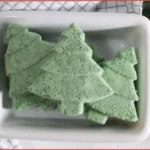Making your own foaming hand soap is surprisingly easy and budget-friendly. It takes only a couple of simple ingredients and a foaming soap dispenser to create a gentle, customizable hand soap that keeps your hands feeling soft.
Adding essential oils is an easy way to customize the scent of the soap and make handwashing a relaxing ritual.
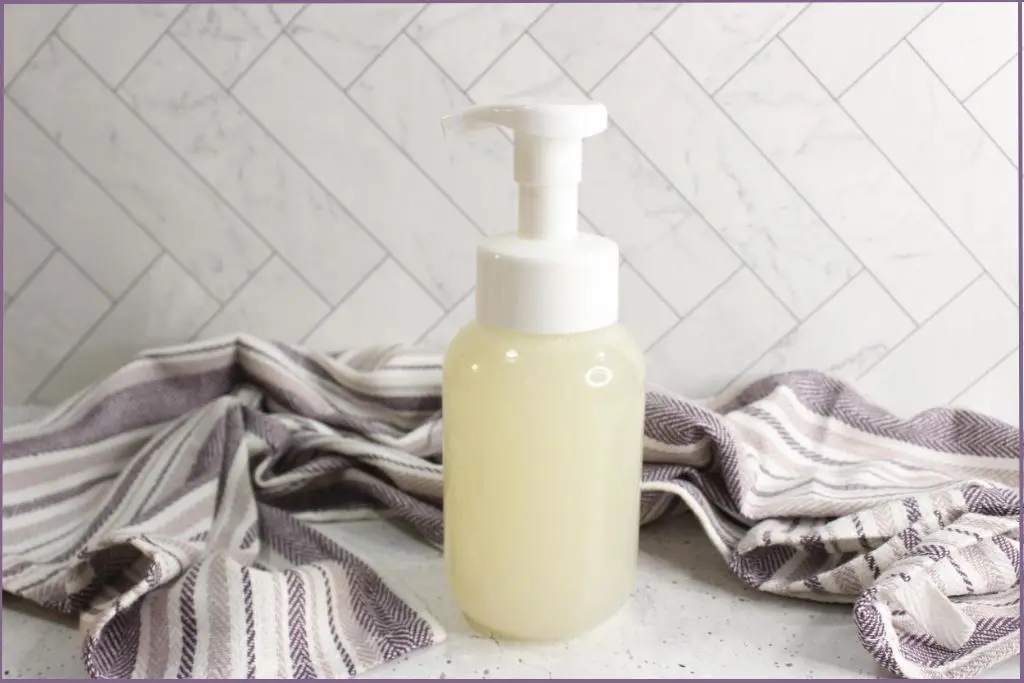
✨ Get 12 Free Holiday Diffuser Blends — Printable PDF
Instantly make your home smell like Christmas with these festive, ready-to-use recipes.
With this easy foaming hand soap recipe and step-by-step instructions, you can mix up a batch in minutes and start enjoying clean hands your way.
Table of Contents
Affiliate Disclosure: Some links on this site are affiliate links. I may earn a small commission if you purchase through them, at no extra cost to you. See the full affiliate disclosure.
Foaming Hand Soap Recipe Key Ingredients

Every great foaming hand soap recipe starts with the right ingredients. These simple, everyday items work together to create a gentle, bubbly soap that’s both effective and fun to use.
Here’s what you’ll need for a homemade foaming hand soap:
Ingredients:
- 2 tablespoons Liquid Castile Soap
- Water
- 1 teaspoon Carrier Oil (optional)
- 20-30 drops Essential Oil (optional)
Supplies:
- Foaming Hand Soap Dispenser
- Measuring Spoons
- Small Bowl or Cup for mixing oils
Notes:
You can swap out carrier oils or use unscented castile soap for sensitive skin.
Essential oils are optional, but they add a lovely scent and extra benefits.
Liquid Castile Soap
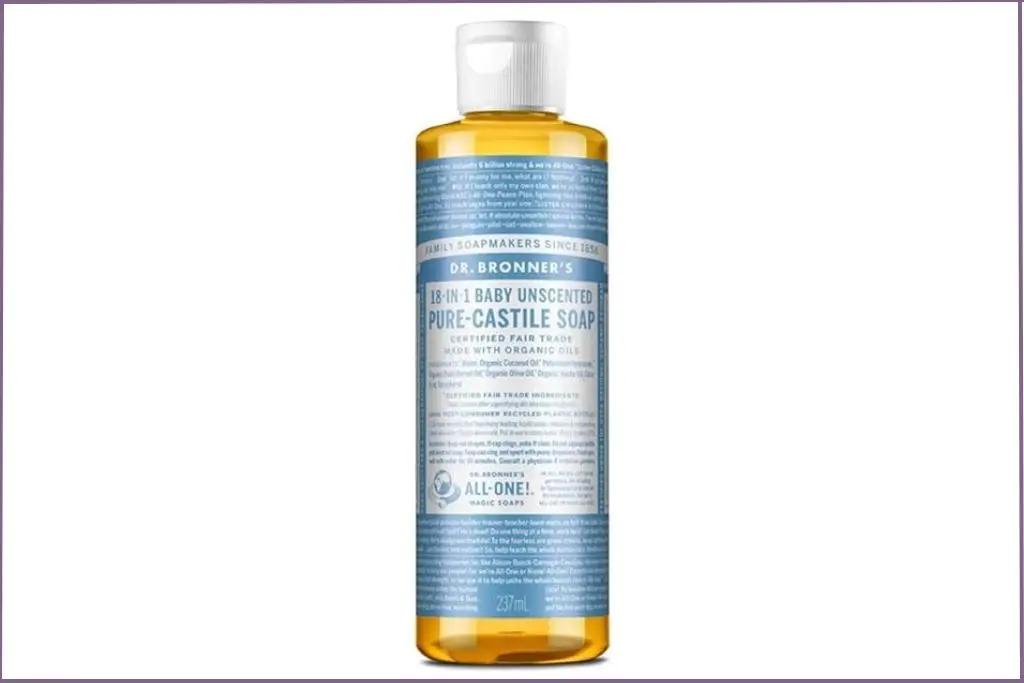
Liquid castile soap is the heart of any natural foaming hand soap recipe. This plant-based soap cleans well without leaving your hands feeling dry.
I love that liquid castile is unscented, which makes it perfect for customizing the scent with essential oils.
A little bit goes a long way. You’ll use just a few tablespoons per bottle, so each batch is affordable and long-lasting.
Water
Water balances out the soap and helps it foam when used in the right dispenser. It also helps stretch your liquid castile soap, making each refill inexpensive.
For best results, use distilled or boiled and cooled water. This keeps your foaming hand soap recipe fresher for longer by limiting bacteria and mineral buildup.
Foaming Soap Dispenser
The secret to fluffy foam isn’t the soap – it’s the dispenser. A foaming soap pump dispenser mixes air with soap and water, creating that signature rich lather
Glass bottles are the best option. They look elegant in kitchens and bathrooms, and don’t interact with essential oils, so the contents remain uncontaminated.
BPA-free plastic bottles are a great alternative for kids and traveling. They are lightweight and durable, and there’s no fear of breaking in your travel case or when kids are using the soap.
Essential Oils
Essential oils turn a plain foaming hand soap recipe into a sensory experience. They smell amazing and allow you to customize every batch with a different scent.
I generally advise diluting essential oils for topical applications. But in this case, you can add essential oils directly to your handmade foaming hand soap. Adding carrier oil is great for other benefits, but it’s not necessary for dilution.
Here’s why: Liquid castile soap itself acts as a mild dispersant and dilutes the essential oils. So, while essential oils should never be applied directly to the skin, they are diluted when mixed with both soap and water in this recipe.
That said, adding carrier oil provides extra skin-softening benefits and further dilutes the essential oils, making the soap gentler, especially for sensitive skin or frequent hand washing.
If you have highly sensitive skin or you’re making soap for young children, including a carrier oil is best practice.
Always use high-quality, skin-safe essential oils. Only add the recommended amount (usually 20-30 drops per 8-10 ounces of finished soap), and never increase the amount to avoid irritation.
Carrier Oil (Optional But Recommended)
Adding a light carrier oil keeps hands soft. Gentle oils like fractionated coconut oil, sweet almond oil, or jojoba oil blend well without making your soap greasy.
Use just a small amount (1-2 teaspoons) per bottle.
Great for dry skin, winter months, or anyone who prefers a more moisturizing soap.
Step-by-Step Instructions: How to Make Foaming Hand Soap With Essential Oils

Here’s how to start whipping up your own handmade foaming hand soap, tailored with your favorite essential oils.
Fill your foaming soap dispenser most of the way full with water, leaving some space at the top for soap and oils. Using water first helps prevent bubbles and mess.
Mix essential oil with carrier oil and stir gently to blend well. This helps disperse the essential oils evenly and makes them gentler on the skin.
Pour the carrier oil and essential oil blend into your dispenser, then add the castile soap.
If necessary, add more water so the container is almost full, but leave enough space for the pump.
Screw on the pump and shake gently to combine everything. Don’t shake too vigorously, or bubbles will start to form, filling up the bottle before you even use it.
That’s it! You’re ready to pump out rich, foamy soap bursting with your signature scent.
Best Essential Oils for Homemade Foaming Hand Soap
Choosing the right essential oils for your foaming hand soap recipe can make all the difference!
The scent you choose creates the vibe every time you use your soap.
Whether you want something calming, energizing, or light and fresh, there’s an oil (or blend) to match your mood and style.
Use these tips and ideas for picking essential oils that work well, smell great, and keep your soap feeling personal and fun.
These essential oils just fit perfectly with hand soap. They blend well with castile soap, bring out the best scents, and are favorites in many homes.
Lavender: The gentle, floral scent of lavender essential oil feels soothing and relaxing. Great for using before bed or after a long day.
Tea Tree: Tea tree essential oil has a crisp, herbal aroma that feels fresh and pure. It is a great choice for kitchens and busy bathrooms.
Lemon: The light, clean, and bright aroma of lemon essential oil will give your hand soap a burst of freshness. It’s the perfect choice if you want your soap to smell extra clean.
Peppermint: Peppermint essential oil is invigorating, cool, and refreshing. It adds a wake-up touch, especially for morning hand washing.
Eucalyptus: The woodsy and refreshing aroma of eucalyptus essential oil gives a spa-like boost to your soap.
Mix and match for unique blends – try lavender with peppermint or lemon with eucalyptus.
Start small when using essential oils. Add one drop at a time for a stronger scent until you’re happy with the results. Don’t overdo it. Too much can ruin the scent and may cause skin irritation.
Foaming Hand Soap Recipe: Customization Ideas
Personalizing the recipe takes it from a basic home project to something that truly fits your daily routine and style. No need to stick with the same formula each time. Switch things up based on the season, skin needs, or your mood.
Rotate scents for different moods or seasons. Add a hint of color with natural mica. Switch carrier oils for softer hands. Personalize bottles with labels or stickers for every sink in the house. Little changes, big perks—all tailored to what you love.
These easy adjustments will help you create a foaming hand soap that’s anything but ordinary.
Ideas For Customizing The Soap Scent
Creating your own scent blends turns your soap into a unique treat. Try these combos for something a little different:
- Fresh Morning: Lemon + Peppermint
- Relaxing Evening: Lavender + Cedarwood
- Kitchen Clean: Tea Tree + Lemon + Rosemary
- Spa Day: Eucalyptus + Lavender + a single drop of Mint
- Warm & Cozy: Sweet Orange + Vanilla Extract (alcohol-free) + Clove
Seasonal Scents:
- Spring: Lemon + Lavender or any citrus-floral combination
- Summer: Orange + peppermint or any citrus-mint combination
- Fall: Get detailed instructions and 5 cozy blend recipes for making fall-scented foaming hand soap.
- Winter: Pine + eucalyptus
- Holidays: Peppermint + Pine is a classic Holiday combination
Make a different blend for the kitchen, bathroom, and kids’ sink.
Write down the blend recipes so you can remake favorites.
Adjust Scent Strength: Prefer a light or bold scent? Use fewer drops of essential oil for something subtle, or increase to 20 drops for a stronger fragrance.
Customization Ideas For Visual Appeal & Individual Preferences
Change Up Color: Add a small pinch of natural mica powder or a drop of plant-based food coloring for a splash of color. Avoid synthetic dyes to keep it gentle on your hands.
Switch Carrier Oils: For softer skin, experiment with different carrier oils. Try jojoba for a light feel, sweet almond for a silky finish, or avocado oil for extra nourishment in winter months.
Add Fun Textures: Sprinkle in dried flower petals, like lavender or calendula. Crush the dried petals fine and use only a tiny bit so your dispenser doesn’t clog.
Make It Kid-Friendly: Use only gentle scents like chamomile or orange from Plant Therapy’s KidSafe line. Let kids help blend the scent to make handwashing fun.
Keep it Unscented for Sensitive Skin: Skip essential oils entirely for those who want a simple, no-frills DIY hand soap with foam.
Bottle and Label Customization Ideas
A personalized bottle makes your foaming hand soap recipe feel special. Here are some quick ways to upgrade your packaging:
- Use a glass foaming dispenser for a touch of elegance.
- Choose a pump color that matches your bathroom or kitchen.
- Add waterproof labels with the scent name or a cheerful quote.
- Let kids decorate their own bottles with stickers.
Extra Nourishment Add-Ins
Winter, dry weather, or lots of hand washing can make hands feel tight. You can add simple, nourishing ingredients to make your soap even better for your skin:
- Vegetable Glycerin: Add ½ teaspoon to boost moisture and create silkier foam.
- Oat Infusion: Soak oats in water, strain, and use that water in your recipe for a calming soap.
- Aloe Vera Juice: Replace half the water with pure aloe juice for extra softness.
Special Mention: DIY Thieves Foaming Hand Soap
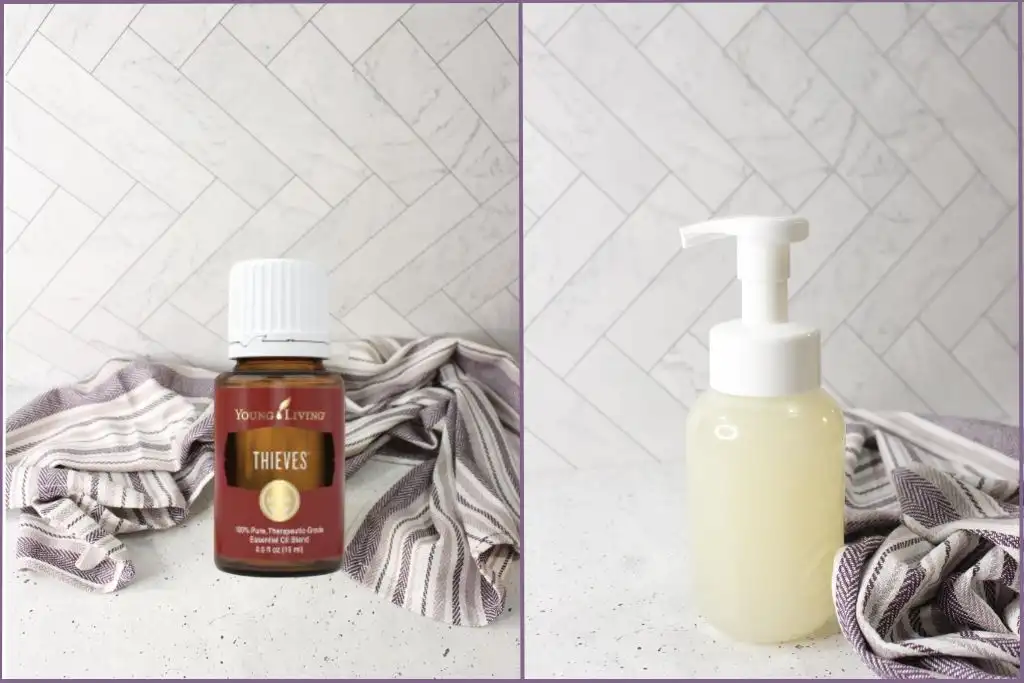
If you love the warm, spicy scent and natural cleaning power of Thieves essential oil, use it to customize the basic foaming hand soap recipe.
Young Living Thieves essential oil is a popular blend inspired by the classic mix of clove, lemon, cinnamon, eucalyptus, and rosemary.
Thieves Foaming Hand Soap Recipe
You can use a premade Thieves blend from Young Living or make your own using this blend recipe:
- 8 drops Clove
- 7 drops Lemon
- 4 drops Cinnamon Bark
- 3 drops Eucalyptus
- 2 drops Rosemary
Follow the basic DIY hand soap foaming instructions above. Add 20-30 drops of premade or homemade Thieves blend to your carrier oil, then add to your soap mixture. Shake to combine.
Benefits of Thieves Foaming Hand Soap Recipe
Thieves essential oil by Young Living is my favorite essential oil to add to homemade soaps. This blend is known as much for its fresh, spicy aroma as for its natural cleansing properties. This makes it an excellent option for use in many different ways for personal care and DIY recipes, including this homemade hand soap.
Thieves-scented foaming hand soap is perfect for kitchens, bathrooms, and even as a seasonal scent. Use this blend to make a germ-fighting, aromatic foaming hand soap.
Make sure to patch test, as spice oils can be more intense for some.
How To Make Foaming Hand Soap: Troubleshooting Tips
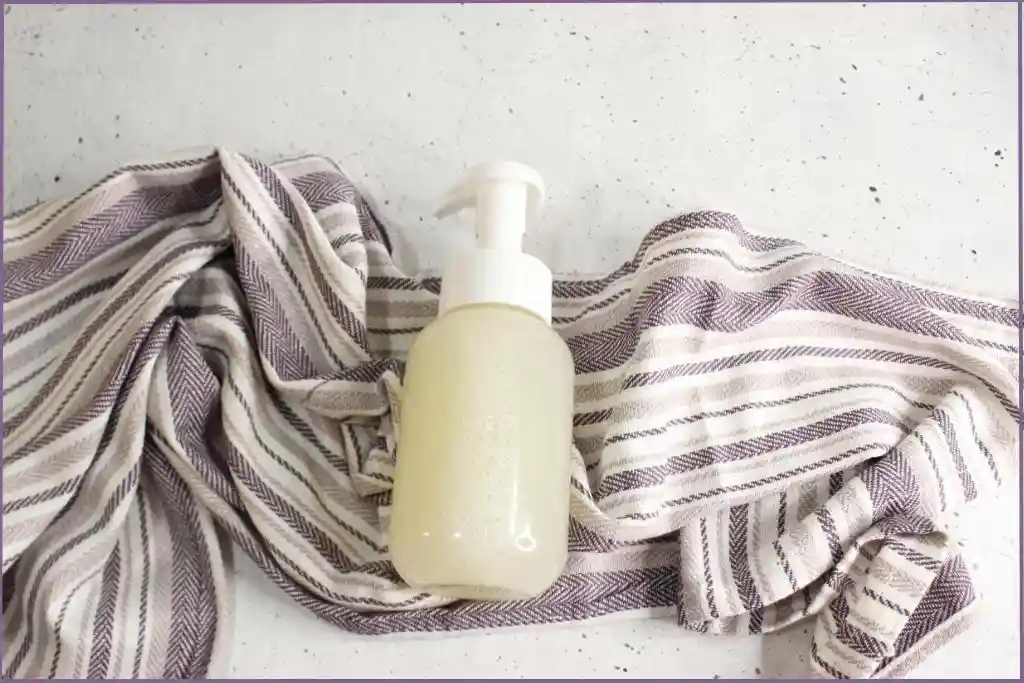
Even with the best foam: ng hand soap recipe, things don’t always go right on the first try. Sometimes the foam isn’t fluffy, the scent isn’t strong, or your dispenser just refuses to work.
Don’t worry, most issues with homemade foaming hand soap are easy to solve. Here’s a simple troubleshooting guide to keep your homemade soap sudsy, smooth, and satisfying.
Soap isn’t foaming well:
- Check if you’re using a foaming dispenser. Standard pump bottles won’t create foam.
- If the mix is too thick, add more water. Too thin? Add a bit more castile soap.
- Make sure the pump is clean and not clogged. Rinse with warm water and try again.
Pump feels stuck or hard to use:
- Disassemble the pump and rinse all parts in warm water. Soap buildup and essential oils can clog the spring or nozzle.
- Let the parts air dry before putting them back together.
Soap feels watery:
- Add another tablespoon of castile soap for additional thickness.
- Shake your bottle before each use to remix any settled ingredients.
Scent is too light or fades fast:
- Add a few more drops of essential oil to your next batch.
- Store your soap in a cool, dark place. Sunlight can weaken scents faster.
Soap separates over time:
- This is normal since natural oils and soap separate over time. Gently shake before each use to mix the layers.
The foaming soap pump dispenser gets clogged:
- Soak the pump in warm water with a drop of vinegar. Pump several times to clear out any leftover soap or oil.
Troubleshooting Tips When Problems Persist
When you face issues, it can be a chance to adjust the foaming hand soap recipe to fit your needs even better.
Here are some tweaks you can try if you keep running into trouble:
- Swap out your water for distilled if you notice cloudiness or faster spoilage.
- Try different brands of castile soap; some lather more than others.
- Add a bit of vegetable glycerin (about ½ teaspoon) for thicker, silkier foam.
- Test a new essential oil blend if your current mix doesn’t hit the right notes for you.
- Go lighter on carrier oils if you notice any residue or greasiness.
- Mixing up a new batch is quick, so it’s easy to experiment and find your favorite blend.
How To Store Homemade Foaming Soap
Proper storage keeps your homemade foaming hand soap fresh and prevents premature degradation.
Store your finished soap in a cool, dry spot away from direct sunlight. This helps keep your essential oils smelling great and prevents the soap from thinning out.
Use up each batch within 3-4 weeks, especially if you use tap water, to keep it fresh. It will last longer with distilled water.
How To Use Homemade Foaming Hand Soap
A little goes a long way. One pump is usually enough for clean hands.
Kids love the foam, so keeping a bottle by the sink is a great way to encourage good hygiene.
Place a bottle in each bathroom, by the kitchen sink, and in the mudroom for quick cleanups after gardening or playing outside. Use different scents in each bottle.
If you want to switch up scents often, keep a backup dispenser with a different blend ready to go. This recipe is gentle enough to use as a face wash too. Or, you can make this gentle honey calendula face wash for another variation.
Making and using your own foaming hand soap or face wash feels good and makes daily routines a bit more special without much effort.
This foaming hand soap recipe is simple, affordable, and lets you skip the mystery ingredients in store-bought options. With a handful of safe supplies and your favorite essential oils, you get a soap that feels gentle, smells great, and leaves a little more room in your budget.
Customizing each batch lets you match your mood, the season, or even your bathroom decor. This soap doesn’t just clean—it adds a small spark of joy to your daily routine.
Ready to try your own blend? Grab your dispenser, pick a scent, and mix up a batch today!
If you’re curious about swaps, safety, storage, or how to make your soap last, you’re not alone. Here you’ll find the quick answers you need so you can feel confident and creative every time you make a new batch.
How To Make Foaming Hand Soap: FAQs
Can I use any dispenser for this hand wash?
Foaming soap needs a special pump. Regular soap dispensers do not create foam because they can’t mix air with the soap and water. Always use a dispenser labeled “foaming”. If your foam isn’t looking fluffy, check the pump first.
What’s the ideal water-to-soap ratio?
The classic foaming hand soap recipe uses about 1 part liquid castile soap to 4 or 5 parts water. For an 8-ounce bottle, add 2-3 tablespoons of soap, then fill with water. If the soap feels too thick or too thin, tweak these amounts. Using more water gives extra foam, while more soap gives a creamier feel.
Do I have to use distilled water?
Distilled or boiled, cooled water keeps your soap fresh longer and cuts down on bacteria or cloudiness. You can use tap water but the soap may spoil faster.
Can I use other soaps besides castile?
Castile soap is popular because it’s gentle, unscented, and plant-based. Other mild, pure soaps can work but check the ingredient label. Avoid soaps with thickeners, lotions, or synthetic fragrances – they can clog your pump or leave buildup. Always test a small batch with any new soap.
Can I use fragrance oils instead of essential oils?
Fragrance oils are made for scent but may have additives or synthetic ingredients. Essential oils are natural and often a better fit for a gentle foaming hand soap recipe. Learn more about the difference between fragrance oils and essential oils.
Will colorants stain my hands or the sink?
No, natural mica powder or plant-based food coloring should not stain, especially in tiny amounts. Always test in a small batch first.
Can I add exfoliants like seeds or coffee grounds to the recipe?
No, these can clog the foaming pump mechanism. Stick with fine, liquid-friendly add-ins like glycerin or aloe.
Will essential oils affect pump function or soap shelf life?
A few drops of essential oil won’t affect the dispenser. Storing your soap away from direct sun will also help your scent last and keep oils from breaking down.
My soap feels too watery, how can I thicken it?
Homemade foaming hand soap is supposed to be thin and watery so the dispenser can easily fluff each pump. Test it with the pump first and only then add a little more castile soap or a few drops of vegetable glycerin if you find that the end product is too watery.
How can I make my soap more moisturizing?
Add a tiny bit of carrier oil like sweet almond, jojoba, or coconut for extra moisturizing. About 1-2 teaspoons in an 8-ounce bottle is enough. IFor additional skin comfort, add ½ teaspoon of vegetable glycerin. Too much can make your soap separate or feel greasy, so keep amounts small.

